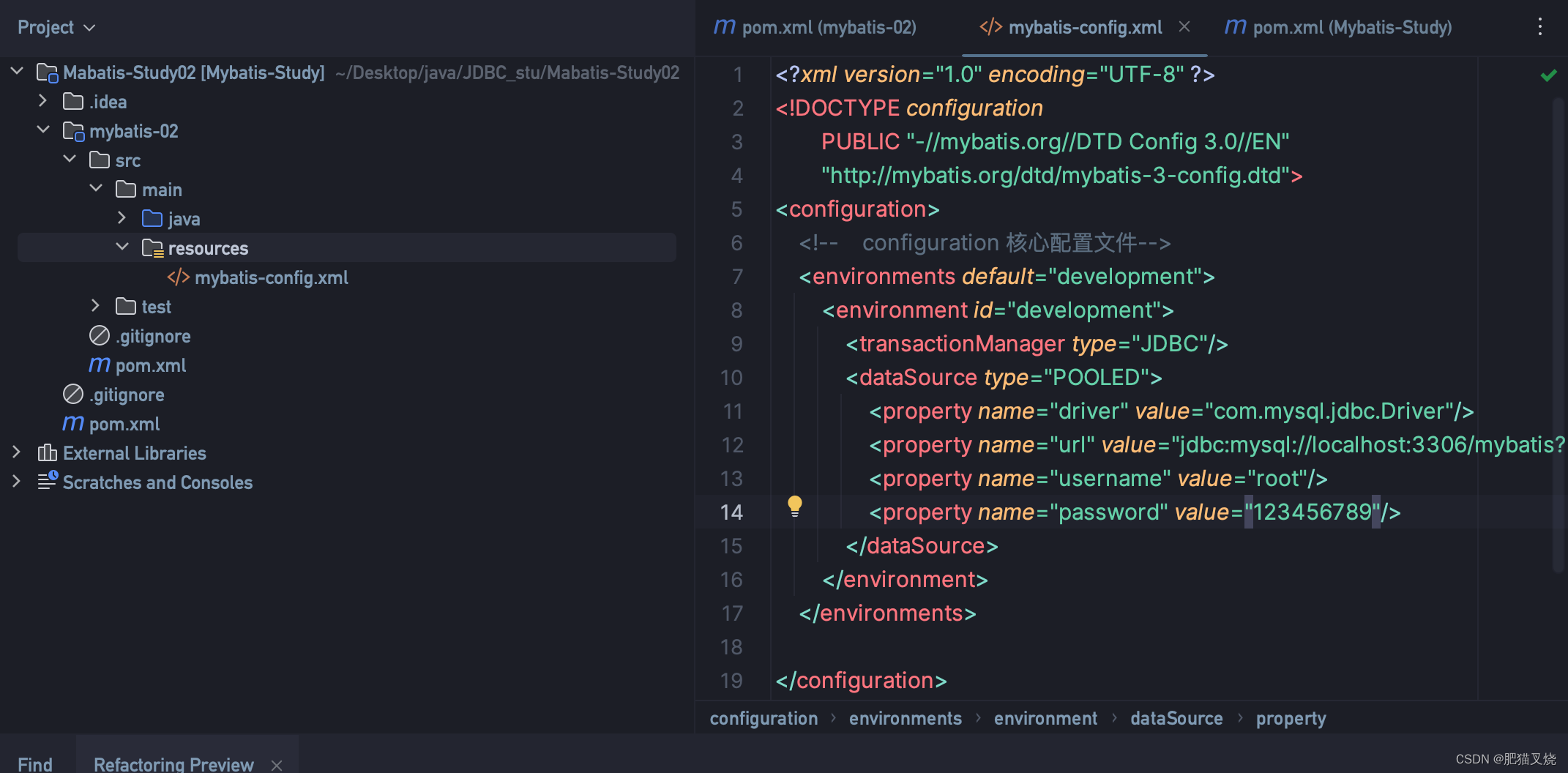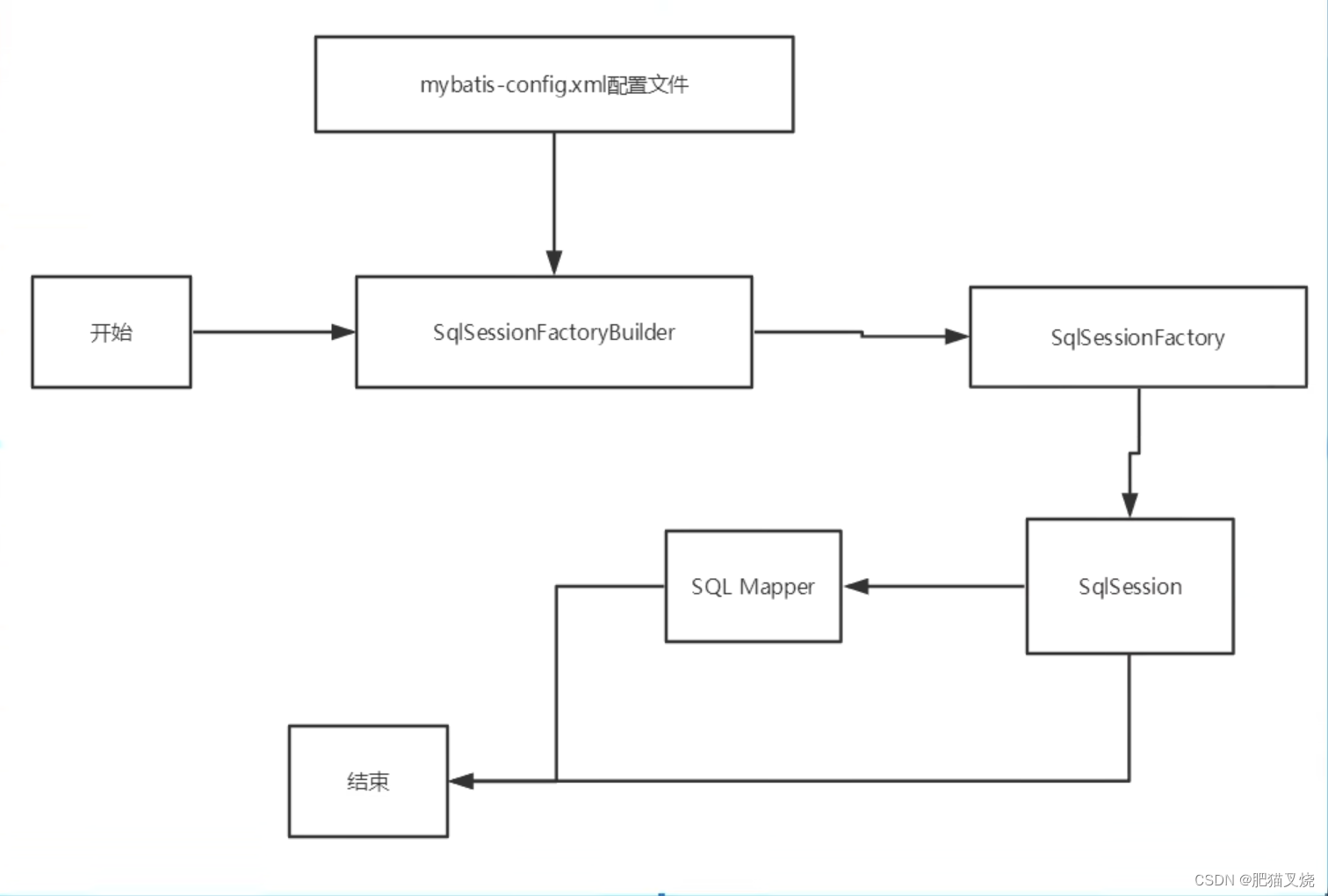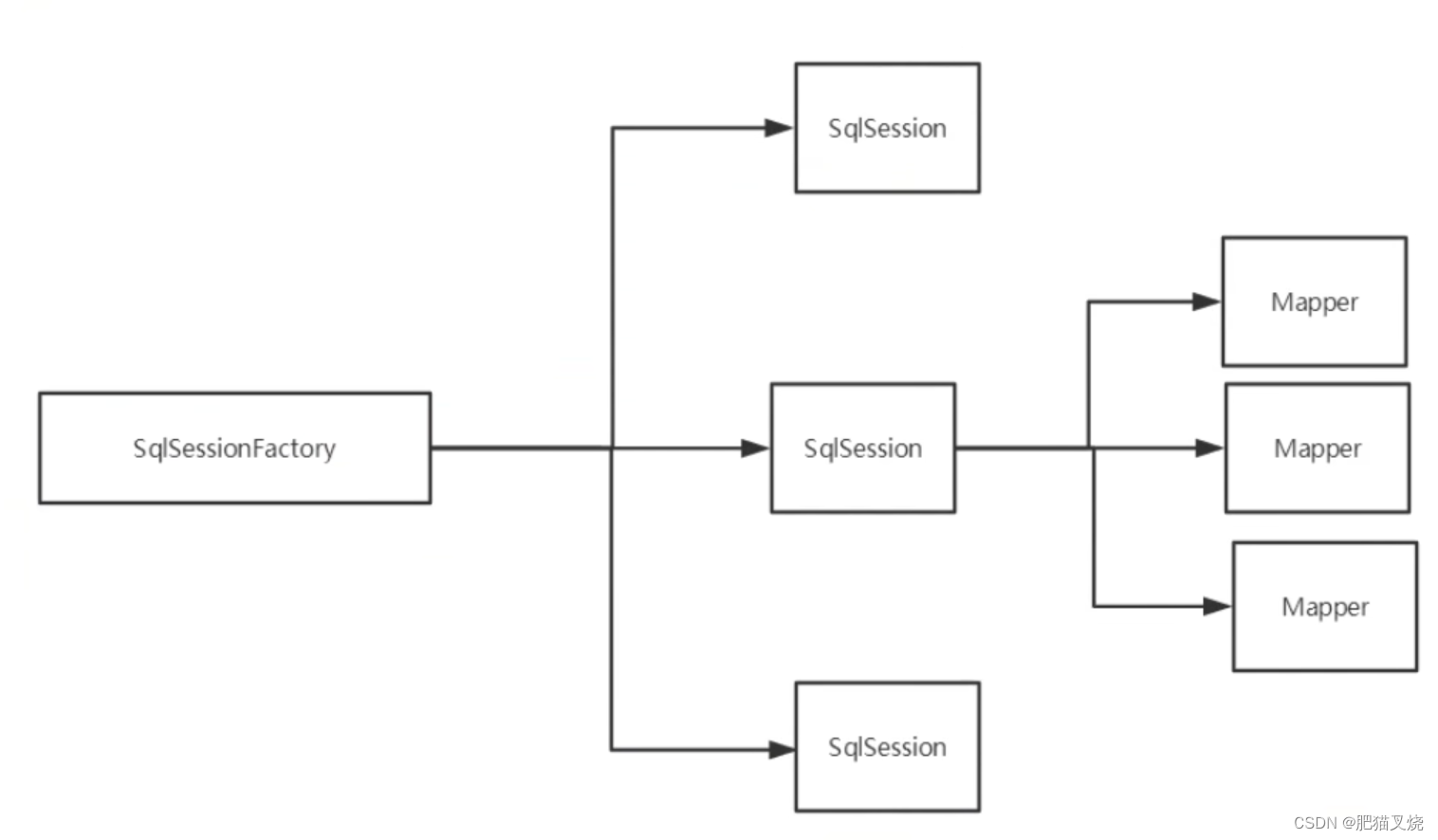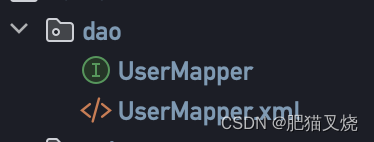MyBatis
1.0 简介
1.1 什么是 MyBatis?
-
MyBatis 是一款优秀的持久层框架
-
它支持自定义 SQL、存储过程以及高级映射。
-
MyBatis 免除了几乎所有的 JDBC 代码以及设置参数和获取结果集的工作。
-
MyBatis 可以通过简单的 XML 或注解来配置和映射原始类型、接口和 Java POJO(Plain Old Java Objects,普通老式 Java 对象)为数据库中的记录。
-
MyBatis本是apache的一个开源项目Batis,2010年这个项目由apache software foundation迁移到了google code,并且改名为MyBatis。
-
2013年11月迁移到Github。
1.2 持久化
数据持久化
-
持久化就是将程序的数据在持久状态和瞬时状态转化的过程
-
例如把数据(如内存)保存到可永久保存的存储设备中(如磁盘)。
-
-
内存:断电即失
-
JDBC就是一种持久化机制。文件IO也是一种持久化机制。
-
数据库是对数据进行持久化的载体
-
狭义的理解: “持久化”仅仅指把域对象永久保存到数据库中;广义的理解,“持久化”包括和数据库相关的各种操作。
-
保存:把域对象永久保存到数据库。
-
更新:更新数据库中域对象的状态。
-
删除:从数据库中删除一个域对象。
-
加载:根据特定的OID,把一个域对象从数据库加载到内存。
-
查询:根据特定的查询条件,把符合查询条件的一个或多个域对象从数据库加载内在存中。
-
为什么需要持久化?
-
持久化技术封装了数据访问细节,为大部分业务逻辑提供面向对象的API
-
通过持久化技术可以减少访问数据库数据次数,增加应用程序执行速度
-
代码重用性高,能够完成大部分数据库操作
-
松散耦合,使持久化不依赖于底层数据库和上层业务逻辑实现,更换数据库时只需修改配置文件而不用修改代码
-
1.3 持久层
持久层:数据库交互
-
也就是我们是常说的dao层。负责数据持久化。
-
持久层就是和数据库交互,对数据库表进行曾删改查的。
1.4 为什么需要MyBatis?
-
传统的 JDBC 代码太复杂
-
SQL和代码的分离,提高了可维护性
-
提供映射标签,支持对象与数据库的orm字段关系映射
-
提供对象关系映射标签,支持对象关系组建维护
-
提供xml标签,支持编写动态SQL
2.0 第一个MyBatis程序
2.1 搭建环境
-
新建一个普通的maven项目
-
删除src目录
-
导入maven依赖
2.2 创建一个模块
-
编写mybatis的核心配置文件(入门_MyBatis中文网)

-
编写mybatis的工具类
//sqlSessionFactory - - > sqlSession
public class MybatisUtils {private static SqlSessionFactory sqlSessionFactory;
static {
try {// 使用Mybatis 第一获取sqlSessionFactory 对象
String resource = "mybatis-config.xml";
InputStream stream = Resources.getResourceAsStream(resource);
sqlSessionFactory = new SqlSessionFactoryBuilder().build(stream);
} catch (IOException e) {e.printStackTrace();
}
}
//既然有了 SqlSessionFactory,顾名思义,我们可以从中获得 SqlSession 的实例。
// SqlSession 提供了在数据库执行 SQL 命令所需的所有方法
public static SqlSession getSqlSession() {return sqlSessionFactory.openSession();
}
}
2.3 编写代码
-
接口实现类 (由原来的UserDaoImpl转变为一个Mapper配置文件)
<?xml version="1.0" encoding="UTF-8" ?>
<!DOCTYPE mapper
PUBLIC "-//mybatis.org//DTD Mapper 3.0//EN"
"http://mybatis.org/dtd/mybatis-3-mapper.dtd">
<!--namespace=绑定一个对应的Dao/Mapper接口-->
<mapper namespace="com.hunter.dao.UserDao">
<!-- 查询语句-->
<select id="getUserList" resultType="com.hunter.pojo.User">
select * from mybatis.user
</select>
<select id="selectBlog" resultType="Blog">
select * from Blog where id = #{id}</select>
</mapper>
-
Dao接口
public interface UserDao {List<User> getUserList();
}
2.4 测试
junit测试
public class UserDaoTest {
@Test
public void test(){
//第一步:获得SqlSession对象
SqlSession sqlSession = MybatisUtils.getSqlSession();
//执行SQL
UserDao userDao= sqlSession.getMapper(UserDao.class);
List<User> userList = userDao.getUserList();
for(User user : userList){
System.out.println(user);
}
//关闭sqlSession
sqlSession.close();
}
}
问题1:ssl问题
解决:把jdbc中的url的ssl改为false
错误信息表明在尝试使用SSL/TLS连接MySQL数据库服务器时出现了问题,具体是由于证书验证问题导致的SSL握手异常。这种情况通常发生在应用程序尝试通过SSL与MySQL服务器通信但遇到自签名或不受信任的证书时。
具体解决:暂时禁用SSL: 如果您正在测试并且只想快速解决问题,可以通过在JDBC URL中添加
useSSL=false参数来临时禁用SSL。但是,请注意,在生产环境中不推荐这样做,因为它将通过明文传输数据。
问题2:由于maven的约定大于配置,我们之后可能遇到我们写的配置文件,无法被导出或者生效的问题
解决:写在pom.xml
<!-- 在bunld中配置resources,来防止我们资源导出失败的问题--><build><resources><resource><directory>src/main/resources</directory><includes><include>**/*.properties</include><include>**/*. xml</include></includes><filtering>true</filtering></ resource><resource><directory>src/main/java</directory><includes><include>**/*. properties</include><include>**/*. xml</include></includes><filtering>true</filtering> </resource></ resources></build>
3.0 CRUD
3.1 namespace
namespace中的包名要和mapper接口的包名一致!
3.2 CRUD
-
Id:就是对应的namespace中的方法名
-
resultType:SQL语句执行的返回值
-
parameterTyper:参数类型
-
⚠️注意:增、删、改需要提交事务
-
sqlSession.commit();
-
1、select
-
编写接口
//根据ID查询用户
User getUserById(int id);
-
编写对应的mapper中的SQL语句
<!-- 根据ID查询用户-->
<select id="getUserById" resultType="com.hunter.pojo.User" parameterType="int">
select * from mybatis.user where id = #{id}
</select>
-
测试
@Test
public void getUserById() {
SqlSession sqlSession = MybatisUtils.getSqlSession();
UserMapper mapper = sqlSession.getMapper(UserMapper.class);
User user = mapper.getUserById(1);
System.out.println(user);
sqlSession.close();
}
2、insert
-
编写接口
//插入一个用户
int addUser(User user);
-
编写对应的mapper中的SQL语句
<!-- 插入一个用户-->
<insert id="addUser" parameterType="com.hunter.pojo.User">
insert into mybatis.user(id, name, pwd) VALUES (#{id},#{name},#{pwd})
</insert>
-
测试
@Test
public void addUser() {
SqlSession sqlSession = MybatisUtils.getSqlSession();
UserMapper mapper = sqlSession.getMapper(UserMapper.class);
int user = mapper.addUser(new User(7, "deadcat2", "666"));
if (user > 0) {
System.out.println("插入成功!");
}
//提交事务
sqlSession.commit();
sqlSession.close();
}
3、update
-
编写接口
//修改一个用户
int updateUser(User user);
-
编写对应的mapper中的SQL语句
<!-- 修改一个用户-->
<update id="updateUser" parameterType="com.hunter.pojo.User">
update mybatis.user set name =#{name}, pwd=#{pwd} where id=#{id}
</update>
-
测试
@Test
public void updateUser() {
SqlSession sqlSession = MybatisUtils.getSqlSession();
UserMapper mapper = sqlSession.getMapper(UserMapper.class);
int user = mapper.updateUser(new User(7, "deadcatty", "999"));
if (user > 0) {
System.out.println("修改成功!");
}
sqlSession.commit();
sqlSession.close();
}
4、delete
-
编写接口
//删除一个用户
int deleteUser(int user);
-
编写对应的mapper中的SQL语句
<!-- 删除一个用户-->
<delete id="deleteUser" parameterType="int">
delete from mybatis.user where id=#{id}
</delete>
-
测试
@Test
public void deleteUser() {
SqlSession sqlSession = MybatisUtils.getSqlSession();
UserMapper mapper = sqlSession.getMapper(UserMapper.class);
int user = mapper.deleteUser(5);
if (user > 0) {
System.out.println("删除成功!");
}
sqlSession.commit();
sqlSession.close();
}
4.0 配置解析
4.1 核心配置文件
-
mybatis-config.xml
-
Mybatis的配置文件包含了会深深影响MyBatis行为的设置和属性信息。
-
configuration(配置)
-
properties(属性)
-
settings(设置)
-
typeAliases(类型别名)
-
typeHandlers(类型处理器)
-
objectFactory(对象工厂)
-
plugins(插件)
-
environments(环境配置)
-
environment(环境变量)
-
transactionManager(事务管理器)
-
dataSource(数据源)
-
-
-
databaseIdProvider(数据库厂商标识)
-
-
4.2 环境配置(environments)
MyBatis可以配置成多种环境
不过要记住:尽管可以配置多个环境,但每个SqlSessionFactory实例只能选择一种环境。
MyBatis默认的事务管理器就是JDBC,连接池:POOLED
4.3 属性(properties)
我们可以通过properties属性来实现引用配置文件
这些属性都是可以外部配置且动态替换的,既可以在典型的Java属性文件中配置(db.properties),也可以通过properties元素的子元素来传递。
-
编写一个配置文件。db.properties
-
这里就是properties 元素中的 resource 属性读取类路径下属性文件
-
driver=com.mysql.jdbc.Driver url=jdbc:mysql://localhost:3306/mybatis?useSSL=false&useUnicode=true&characterEncoding=UTF-8 username=root password=123456789
-
在核心配置文件中映入
<!-- configuration 核心配置文件-->
<configuration>
<!-- 引入外部配置文件 -->
<properties resource="db.properties">
<!-- properties 元素体内指定的属性 -->
<property name="username" value="dev_user"/>
<property name="password" value="123456"/>
</properties>
......
<property name="driver" value="${driver}"/>
<property name="url" value="${url}"/>
<property name="username" value="${username}"/>
<property name="password" value="${password}"/>
......
-
这些属性可以在外部进行配置,并可以进行动态替换。你既可以在典型的 Java 属性文件(db.properties)中配置这些属性,也可以在 properties 元素的子元素中设置。
-
如果一个属性在不只一个地方进行了配置,那么,MyBatis 将按照下面的顺序来加载:
-
首先读取在 properties 元素体内指定的属性。
-
然后根据 properties 元素中的 resource 属性读取类路径下属性文件,或根据 url 属性指定的路径读取属性文件,并覆盖之前读取过的同名属性。
-
最后读取作为方法参数传递的属性,并覆盖之前读取过的同名属性。
就近读,远处后来同名者居上
-
4.4 类型别名(typeAliases)
第一种:
-
类型别名是为 Java 类型设置一个短的名字。
-
存在的意义仅在于用来减少类完全限定名的冗余。
<!-- 可以给实体类起别名-->
<typeAliases>
<typeAlias type="com.hunter.pojo.User" alias="User"/>
</typeAliases>
第二种:
-
也可以指定一个包名,MyBatis会在包名下面搜索需要的 JavaBean
-
扫描实体类的包,它的默认别名就为这个类的 类名,首字母小写,比如:
<typeAliases>
<package name="com.hunter.pojo"/>
</typeAliases>
总结:
在实体类比较少的时候,使用第一种方式。
如果实体类十分多,建议使用第二种。
第一种可以DIY别名,第二种则需要通过在实体类(JavaBean)上增加注解
@Alias("user") public class User { ... }
4.5 设置
详情见 官方文档:配置_MyBatis中文网
4.6 映射器(mappers)
MapperRegistry:注册绑定我们的Mapper文件;
方式一:使用相对于类路径的资源(resource)引用(推荐使用!)
<!--每一个Mapper.XML 都需要在Mybatis核心配置中注册!--> <mappers> <mapper resource="com/hunter/dao/UserMapper.xml"/> </mappers>
方式二:使用class文件绑定注册
<!--每一个Mapper.XML 都需要在Mybatis核心配置中注册!--> <mappers> <mapper class="com.hunter.dao.UserMapper"/> </mappers>
⚠️注意点:
接口和他的Mapper配置文件必须同名
接口和他的Mapper配置文件必须在同一个包下
方式三:使用扫描包进行注入绑定
<mappers> <package name="com.hunter.dao"/> </mappers>
⚠️注意点:
接口和他的Mapper配置文件必须同名
接口和他的Mapper配置文件必须在同一个包下
4.7 生命周期和作用域
生命周期 和 作用域 是至关重要的,因为错误的使用会导致非常严重的并发问题。

SqlSessionFactoryBuilder:
-
一旦创建SqlSessionFactory,就不再需要它了
-
局部变量
SqlSessionFactory:
-
可以想象为“数据库连接池”
-
一旦被创建就应该在应用的运行期间一直存在,不能丢弃它也不能重新创建另一个
-
因此 SqlSessionFactory 的最佳作用域是应用作用域(application)
-
最简单的就是使用单例模式或者静态单例模式
SqlSession:
-
连接到连接池的一个请求
-
SqlSession 的实例不是线程安全的,因此是不能被共享的,所以它的最佳的作用域是请求或方法作用域
-
用完之后需要赶紧关闭,否则资源被占用

每一个Mapper就代表一个具体的业务!!
5.0 解决属性名和字段名不一致的问题
解决方法:
-
-
起别名
<!-- 根据ID查询用户-->
<select id="getUserById" resultType="com.hunter.pojo.User" parameterType="int">
select id,name,pwd as password mybatis.user where id = #{id}</select>
-
-
-
结果集映射(resultMap)
<!--结果集映射-->
<resultMap id="UserMap" type="User">
<!--column数据库中的字段,property实体类中的属性-->
<result column="id" property="id"/>
<result column="name" property="name"/>
<result column="pwd" property="password"/>
</resultMap>
<select id="getUserById" resultType="com.hunter.pojo.User" parameterType="int">
select * from mybatis.user where id = #{id}</select>
-
resultMap 元素是 MyBatis 中最重要最强大的元素
-
resultMap 的设计思想是,对于简单的语句根本不需要配置显式的结果映射,而对于复杂一点的语句只需要描述它们的关系就行了
-
resultMap最优秀的地方在于,虽然你对它已经相当了解了,但是根本就不需要显式地用到他们。
-
6.0 日志
6.1 日志工厂
如果一个数据库操作,出现了异常,我们需要报错。日志就是最好的助手!

-
SLF4J
-
LOG4J (掌握)
-
LOG4J2
-
JDK_LOGGING
-
COMMONS_LOGGING
-
STDOUT_LOGGING (掌握)
-
NO_LOGGING
在Mybatis中具体使用哪一个日志实现,在设置中设定
STDOUT_LOGGING ——标准日志输出
<!--在mybatis核心配置文件中,配置我们的日志--> <settings> <setting name="logImpl" value="STDOUT_LOGGING"/> </settings>
6.2 LOG4J
什么是LOG4J ?
LOG4J 是Apache的一个开源项目,通过使LOG4J,我们可以控制日志信息输送的目的地是控制台、文件、GUI组件
我们也可以控制每一条日志输出格式
通过定义每一条信息的级别,我们能够更加细致地控制日志生成过程
通过一个配置文件来灵活进行配置,而不需要修改应用的代码
7.0 分页
思考:为什么要分页?
-
减少数据处理量
7.1 使用Iimit分页
语法:-- 每页有pageSize个,从startIndex开始查询 select * from `user` limit startIndex,pageSize; -- [0,n] select * from `user` limit n;
使用Mybatis实现分页
-
接口
//分页 List<User> getUserByLimit(Map<String, Integer> map);
-
Mapper.xml
<!-- 分页--> <select id="getUserByLimit" parameterType="map" resultType="user"> select * from mybatis.user limit #{startIndex}, #{pageSize} </select> -
测试
@Test
public void getUserByLimit() {
SqlSession sqlSession = MybatisUtils.getSqlSession();
UserMapper mapper = sqlSession.getMapper(UserMapper.class);
HashMap<String, Integer> map = new HashMap<>();
map.put("startIndex", 0);
map.put("pageSize", 2);
List<User> userList = mapper.getUserByLimit(map);
for (User user : userList) {
System.out.println(user);
}
sqlSession.close();
}
8.0 使用注解
8.1 面向接口编程
-
大家之前都学习过面向对象编程,也学习过接口。但在真正的开发中,我们会选择面向接口编程
-
根本原因:解耦,可拓展,提高复用,分层开发中,上层不用管具体的实现,大家都遵守共同的标准,使得开发变得容易,规范性更好
-
在一个面向对象的系统中,系统各种功能室友许多不同的对象协作完成的。在这种情况下,各个对象内部是如何实现的,对系统设计人员来说就不那么重要了
-
而各个对象之间的协作关系则成为系统设计的关键。小到不同类之间的通信,大到各模块之间的交互,在系统设计之初都是要着重考虑的,这也是系统设计的主要工作内容。面向接口编程就是按照这种思想来编程。
关于接口的理解
-
接口从更深层次的理解,应该是定义与实现的分类。
-
接口的本身反映了系统设计人员对系统的抽象理解。
接口有两类:
-
对一个个体的抽象,它对应一个抽象体(abstract class)
-
对一个个体某一方面的抽象,即形成一个抽象(interface)
-
一个个体可能有多个抽象面(interface)。
-
抽象体(abstract class)和抽象面(interface)是有区别的。
-
三个面向的区别
-
面向对象 是指,我们考虑问题时,以对象为单位,考虑它的属性以及方法。
-
面向过程 是指,我们考虑问题时,以一个具体的流程(事务过程)为单位,考虑它的实现。
-
接口设计 与 非接口设计 是针对复用技术而言的,与面向对象(过程)不是一个问题。更多是对系统整体的架构。
8.2 使用注解开发
-
注解在接口上实现
@Select("select * from user") List<User> getUsers(); -
需要在核心配置文件中绑定接口
<!--绑定接口--> <mappers> <mapper class="com.hunter.dao.UserMapper"/> </mappers>
-
测试
本质:反射机制实现
底层:动态代理
9.0 多对一处理
9.1 测试环境搭建
-
新建实体类Teacher,Student
-
新建Mapper接口
-
建立Mapper.XML文件
-
在核心配置文件中绑定注册我们的Mapper接口或者文件!
-
测试查询是否能够成功!
9.2 按照查询嵌套查询
<!--
思路:
1. 查询所有的学生信息
2. 根据查询出来的学生的tid,寻找对应的老师
-->
<select id="getStudent" resultMap="StudentTeacher">
select * from student
</select>
<resultMap id="StudentTeacher" type="Student">
<result property="id" column="id"/>
<result property="name" column="name"/>
<!-- 复杂的属性,我们需要单独处理
对象:association
集合:collection
-->
<association property="teacher" column="tid" javaType="Teacher" select="getTeacher"/>
</resultMap>
<select id="getTeacher" resultType="Teacher">
select * from teacher where id = #{id}
</select>
9.3 按照结果嵌套查询
<!-- 按照结果嵌套查询-->
<select id="getStudent2" resultMap="StudentTeacher2">
select s.id sid,s.name sname , t.name tname
from student s ,teacher t
where s.tid = t.id;
</select>
<resultMap id="StudentTeacher2" type="Student">
<result property="id" column="sid"/>
<result property="name" column="sname"/>
<association property="teacher" javaType="Teacher">
<result property="name" column="tname"/>
</association>
</resultMap>
回顾MySQL多对一查询:
子查询
联表查询
10.0 一对多处理
比如:一个老师拥有多个学生
对于老师而已就是一对多的关系
实体类
//学生
public class Student {
private int id;
private String name;
private int tid;
@Override
public String toString() {
return "Student{" +
"id=" + id +
", name='" + name + '\'' +
", tid=" + tid +
'}';
}
}
//老师
public class Teacher {
private int id;
private String name;
@Override
public String toString() {
return "Teacher{" +
"id=" + id +
", name='" + name + '\'' +
", students=" + students +
'}';
}
// 一个老师拥有多个学生(添加学生的集合)
private List<Student> students;
}
按照结果查询处理
<!-- 按结果嵌套查询-->
<select id="getTeacher" resultMap="TeacherStudent">
select s.id sid, s.name sname, t.id tid, t.name `tname`
from mybatis.student s,
mybatis.teacher t
where s.tid = t.id
and t.id = #{tid}
</select>
<resultMap id="TeacherStudent" type="Teacher">
<result property="id" column="tid"/>
<result property="name" column="tname"/>
<!--
复杂的属性,我们需要单独处理
对象:association
集合:collection
JavaType :指定属性的类型
集合中的泛型信息,我们使用ofType获取
-->
<collection property="students" ofType="Student">
<result property="id" column="sid"/>
<result property="name" column="sname"/>
<result property="tid" column="stid"/>
</collection>
</resultMap>
小结
关联 - association(多对一)
集合 - collection(一对多)
javaType & ofType
javaType 用来指定实体类中属性的类型
ofType 用来指定映射到 List 或者 集合中的 pojo 类型,泛型中的约束类型
⚠️注意点:
保证SQL可读性
注意一对多 和 多对一 中 ,属性名和字段的问题
11.0 动态SQL
11.1 什么是动态SQL?
动态SQL:根据不同的条件生存不同的SQL语句
动态 SQL 元素可能会感觉似曾相识。在 MyBatis 之前的版本中,需要花时间了解大量的元素。借助功能强大的基于 OGNL 的表达式,MyBatis 3 替换了之前的大部分元素,大大精简了元素种类,现在要学习的元素种类比原来的一半还要少。
if
choose (when, otherwise)
trim (where, set)
foreach
11.2 搭建环境
CREATE TABLE `blog`( `id` VARCHAR(50) NOT NULL COMMENT '博客id', `title` VARCHAR(100) NOT NULL COMMENT '博客标题', `author` VARCHAR(30) NOT NULL COMMENT '博客作者', `create_time` DATETIME NOT NULL COMMENT '创建时间', `views` INT(30) NOT NULL COMMENT '浏览量' )ENGINE=INNODB DEFAULT CHARSET=utf8;
创建一个基础工程
-
导包
-
编写配置文件
<mappers>
<mapper class="com.hunter.dao.BlogMapper"/>
</mappers>
-
编写实体类
public class Blog {private String id;
private String title;
public String getId() {return id;
}
public void setId(String id) {this.id = id;
}
public String getTitle() {return title;
}
public void setTitle(String title) {this.title = title;
}
public String getAuthor() {return author;
}
public void setAuthor(String author) {this.author = author;
}
public Date getCreateTime() {return createTime;
}
public void setCreateTime(Date createTime) {this.createTime = createTime;
}
public int getViews() {return views;
}
public Blog() {}
public Blog(String id, String title, String author, Date createTime, int views) {this.id = id;
this.title = title;
this.author = author;
this.createTime = createTime;
this.views = views;
}
public void setViews(int views) {this.views = views;
}
private String author;
private Date createTime;
private int views;
@Override
public String toString() {return "Blog{" +"id='" + id + '\'' +
", title='" + title + '\'' +
", author='" + author + '\'' +
", createTime=" + createTime +
", views=" + views +
'}';
}
}
-
编写实体类对应的 Mapper接口 和 Mapper.xml 文件
public interface BlogMapper {
//插入数据
int addBlog(Blog blog);
}
<mapper namespace="com.hunter.dao.BlogMapper">
<insert id="addBlog" parameterType="Blog">
insert into mybatis.blog(id, title, author, create_time, views)
VALUES (#{id},#{title},#{author},#{createTime},#{views});
</insert>
11.3 IF
<!-- 查询博客-->
<select id="queryBlogIF" parameterType="map" resultType="com.hunter.pojo.Blog">
select * from mybatis.blog
<where> <!--where标签-->
<if test="title != null">
and title=#{title}
</if>
<if test="author != null">
and author=#{author}
</if>
</where> <!--where标签-->
</select>
11.4 choose (when,otherwise) (有点像switch...case,只执行一个条件,第一个满足了,后面的条件就不执行)
我们不想使用所有的条件,而只是想从多个条件中选择一个使用
<!-- 查询博客-->
<select id="queryBlogIF" parameterType="map" resultType="com.hunter.pojo.Blog">
select * from mybatis.blog
<where>
<choose>
<when test="title != null">
title = #{title}
</when>
<when test="author != null">
and author = #{author}
</when>
<otherwise>
and views = #{views}
</otherwise>
</choose>
</where>
</select>
11.5 trim (where, set)
<where>
<if test="title != null">
and title=#{title}
</if>
<if test="author != null">
and author=#{author}
</if>
</where>
所谓的动态SQL,本质还是SQL语句,只是我们可以在SQL层面,执行一个逻辑代码
if
where 、 set 、choose 、when
SQL片段
有的时候,我们会将一些功能的部分抽取出来,方便复用
-
使用SQL标签抽取公共部分
<!-- SQL片段-->
<sql id="when-title-author-views">
<choose>
<when test="title != null">
title = #{title}
</when>
<when test="author != null">
and author = #{author}
</when>
<otherwise>
and views = #{views}
</otherwise>
</choose>
</sql>
-
在需要使用的地方使用include标签引用即可
<!-- 查询博客-->
<select id="queryBlogIF" parameterType="map" resultType="com.hunter.pojo.Blog">
select * from mybatis.blog
<where>
<!-- include标签-->
<include refid="when-title-author-views"></include>
</where>
</select>
⚠️ 注意事项:
最好基于单表来定义SQL片段
不要存在where标签
11.6 foreach
12.0 缓存
12.1 简介
查询:连接数据库,很消耗资源
把查询的结果,暂存在一个地方-->内存 :缓存
再次查询相同数据时,直接去缓存查询,不用再从数据库中查询
-
什么是缓存(cache)?
-
存储在内存中的临时数据
-
将用户经常查询的数据放在缓存(内存)中,用户查询数据时就不用从磁盘(关系型数据库数据文件)查询,而是直接从缓存中查询,从而提高查询的效率,解决了高并发系统的性能问题。
-
-
为什么使用缓存?
-
减少和数据库的交换次数,减少系统开销,提高系统效率。
-
-
什么样的数据能使用缓存?
-
经常查询并且不经常改变的数据。
-
12.2 Mybatis缓存
-
MyBatis包含一个非常强大的查询缓存特性,它可以非常方便地定制和配置缓存。缓存可以极大的提升查询效率。
-
MyBatis系统中默认定义了两级缓存:一级缓存 和 二级缓存
-
默认情况下,只有一级缓存开启。(SqlSession级别的缓存,也称为本地缓存)
-
二级缓存需要手动开启和配置,它是基于namespace级别的缓存
-
为了提高扩展性,MyBatis定义了缓存接口Cache。我们可以通过实现Cache接口来自定义二级缓存
-
12.3 一级缓存
-
一级缓存也叫本地缓存:SqlSession
-
与数据库同一次会话期间查询到的数据会放在本地缓存中
-
以后如果需要获取相同的数据,直接从缓存中拿,没必要再去查询数据库
-
缓存失效的情况:
查询不同的东西
增删改查操作,可能会改变原来的数据,所以必定会刷新缓存
查询不同的Mapper.xml
手动清理缓存( SqlSession.clearCache( ) )
**小结:一级缓存默认是开启的,只在一次SqlSession中有效,也就是拿到连接到关闭连接这个区间段!
12.4 二级缓存
-
二级缓存也叫全局缓存,一级缓存作用域太低了,所以诞生了二级缓存
-
基于namespace级别的缓存,一个namespace,对应一个二级缓存
-
工作机制
-
一个会话查询一条数据,这条数据就会放在当前会话的一级缓存中
-
如果当前会话关闭了,这个会话对应的一级缓存就没了。但是我们需要的是,会话关闭了,一级缓存中的数据被保存到二级缓存中
-
新的会话查询信息,就可以从二级缓存中获取内容
-
不同的mapper查询出的数据会放在自己的对应的缓存(map)中
-






















 5268
5268

 被折叠的 条评论
为什么被折叠?
被折叠的 条评论
为什么被折叠?








